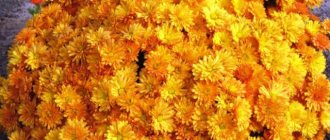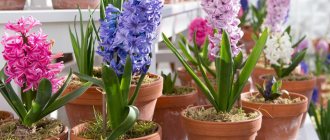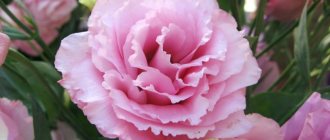Green chrysanthemums are a popular variety of this ornamental crop. These flowers are actively used in floristry to create beautiful compositions, and are also sometimes grown by true connoisseurs to decorate the landscape design of flower beds and front gardens. There are several varieties of this variety, and each of them looks very impressive and original.
Green chrysanthemums retain their freshness for a long time and do not fade for a long time
Description of bush chrysanthemum
The plant belongs to the Asteraceae family. The height of the flower can vary from 30 cm to 1.5 meters. The shade range is very wide, so every gardener will be able to find his own chrysanthemum color that will fit perfectly into the flower garden. There are even green chrysanthemums. The bush type of such a flower can be grown in one place for up to 5 years .
However, over time it begins to lose its decorative properties.
All varieties differ in stem height, flower shape and bud shade. A novice gardener should pay attention to the following varieties of bush chrysanthemums:
These are not all varieties of bush chrysanthemums. In fact, there are many more of them. Particular attention should be paid to the characteristics of green chrysanthemum. This is an original flower that will help refresh any flower bed or flower arrangement.
This green flower comes in the following subspecies:
What do green chrysanthemums symbolize?
The cultural traditions of the peoples of the East gave Europeans the custom of creating and presenting bouquets that carry a certain meaning. Understanding the “language of flowers”, the ability to decipher their meaning and correctly write a description is a real art.
In this language, chrysanthemum, which is popularly called the “queen of autumn,” denotes chastity and calm beauty, dignity and perfection, abundance and perseverance in the face of adversity and blows of fate. In the past, images of these flowers symbolized power and nobility, longevity and happiness. Now their different shades have their own symbolic meaning.
All shades of green have positive associations. They remind of childhood and youth, joy, harmony, tranquility, wisdom, and also embody hopes for a happy future.
Features of planting and propagation
Garden bush chrysanthemum is undemanding to the soil and planting site.
The first stage of planting such a flower is to choose a suitable place. The plant will bloom even in partial shade, but it is still better to plant it in a sunny area. But it should be remembered that hot weather, especially at night, can negatively affect flowering. There are several options for propagating such a plant. So, chrysanthemum propagation can occur in three ways:
Even if you have no experience in planting such flowers, you should not worry, since the plant is quite unpretentious, so planting it is not so difficult.
Growing from seeds
This landing option is not the most popular.
The main disadvantage is that flowers grown from seeds are not always similar to the chrysanthemums from which the seeds were collected. To get flowering in the year of planting, you should grow seedlings, and only then transplant them into open ground. Seeds should be planted in January or February. This planting option involves the following algorithm of actions: After planting the seeds in pots, they should be looked after . The quality of care depends on how quickly the sprouts appear. The temperature of the room in which the plant is located should be 23-25 degrees. Under comfortable conditions, the first shoots begin to appear within 1.5-2 weeks after sowing the seeds.
The next stage is caring for the seedlings. When it has risen, it should be dived into different containers. For replanting, you should use the same soil that was used for planting the seeds. After picking, the plants need to be sprinkled with a special solution that will help them take root better.
In about a month, the seedlings should grow to 20 cm, and then they can be transplanted into open ground. When a constant temperature of 15-18 degrees is established, the seedlings can begin to harden. It can be planted in open ground as early as early June.
Planting seeds directly into the ground has its own characteristics. So, you need to follow the scheme:
What are Korean chrysanthemums?
Most gardeners prefer to grow Korean chrysanthemums on their plots - hybrids that are perfectly adapted for cultivation in open ground. The second name of these frost-resistant, unpretentious flowers in planting and care is the Korean chrysanthemum Oak. Its origin is explained by the fact that the leaves of most Korean varieties resemble oak leaves in shape and structure.
Initially, Japanese breeders tried to obtain varieties of Korean “beauties”, using small-flowered varieties, including Korean ones, as a basis. In Russia, the first few attempts to grow them in open ground date back to the end of the 19th century. But their selection and cultivation began seriously only in the early 40s of the 20th century, shortly before the start of the Great Patriotic War.
All chrysanthemums are Korean perennial plants. Their popularity among flower growers around the world is explained by their wide decorative capabilities, long and continuous flowering, variety of appearance, and ease of care. In addition, the correct distribution of various species by planting time makes it possible to admire their lush beauty from the last days of July until late autumn.
Many people wonder how Korean varieties differ from multiflora. In fact, this question is not correct, since Korean oak trees are not an independent species, and multiflora, if it is frost-resistant, is included in this group.
Plant care tips
Spray chrysanthemums do not require special care.
It is enough to choose the right place for planting, make good drainage, periodically water and feed them. Chrysanthemums do not tolerate waterlogging, as it can provoke the appearance of fungal diseases or pests. Therefore, moderate watering will protect the flower from insect attack and rotting.
Bushes should be trimmed periodically . To get a lush bush, you sometimes need to cut off the top. We should also not forget about sanitary trimmings. Removing old and diseased branches will prevent the appearance of various pathologies and diseases.
Fertilizers should be selected depending on the time of year . In spring and early summer, it is recommended to use nitrogen fertilizers. They are needed to stimulate flower growth. At the end of summer, potassium and phosphorus compositions should be used for feeding. They promote abundant flowering. In autumn, it is better not to feed the plant with nitrogen compounds. Otherwise, next year a large bush will grow, but without flowers. A plant that grew on nitrogen fertilizer may simply not survive the winter.
Bush chrysanthemums of frost-resistant varieties do not need to be dug up for the winter. They should be well insulated. For this purpose, you can use polyethylene and a wooden frame. But non-frost-resistant varieties should be dug up and placed in a greenhouse or cellar. The peculiarity of such flowers is that the larger the chrysanthemum, the worse it tolerates bad weather conditions.
Varieties
Today, bush chrysanthemum is very popular. In addition to its unpretentiousness, it fits perfectly into any landscape design due to the variety of its varieties and hybrid forms.
According to the shape of the inflorescences, bush garden chrysanthemums are divided into the following types:
Pom poms with petals in the shape of tongues, collected in a ball resembling a pompom.
- Anemoid, in which the buds consist of large petals collected in 1-3 rows. The flowers with tongue-like petals are not very large in size.
- Semi-double, consisting of 3 rows of tongues located around the center of the bud.
- Terry, distinguished by the variety and splendor of species and shapes.
Among these plants there are annual and perennial varieties. The first are represented by the following types: prominent, keeled, crowned, sowing. The main perennial varieties are white bush chrysanthemum and large one. For cultivation in open ground, varieties that are resistant to various ailments, climatic and weather conditions, and pests are usually used.
There are a huge number of varieties, and it is unrealistic to consider all these options in one article. Below are the names of bush chrysanthemums - the most popular crops loved by domestic gardeners.
Pests and diseases
If you do not follow basic care recommendations, the plant may suffer from various insects and diseases.
The most common insect is aphids. If treatment is not started in time, the plant may die. The treatment method is selected depending on the degree of damage to the flower. A small number of insects that are concentrated in one place can be gotten rid of by removing the branch. In case of extensive damage, special means should be used. So, such drugs include Actellik, Calypso and Aktara. Sometimes chrysanthemums are affected by small worms. They can only be noticed by their metabolic results, which appear on the leaves in the form of whitish spots that eventually turn brown. The worms begin to infect the plant from below. Affected buds may even bloom, but they will be ugly in appearance. To prevent further spread of pests, it is recommended to burn the affected bush . For prevention, the plant can be treated with a phosphamide solution.
Features of the chrysanthemum variety Filin Green
The bright green pompom beauty Feeling Green is the embodiment of fashion trends in the world of floriculture. The variety was bred in Holland in 2005 by breeders of the Fides company. It was the first green chrysanthemum to become a commercially successful variety due to its exceptional appearance and ability to remain fresh for a long time when cut. The flower began to be actively used to create exclusive bouquet arrangements. And thanks to the emergence of the Dark mutation, the Philing Green Dark chrysanthemum variety appeared, even darker and more saturated, and the shade of green inflorescences became even more expressive.
Among chrysanthemums, unusual shapes and colors of inflorescences have recently been considered especially fashionable: pompom and spider-like varieties of green, greenish-white and greenish-yellow.
Owl Green - bush chrysanthemums. The flowers are small and shaped like dense pompoms. Their diameter can range from 3 to 7 cm. The petals fit well to each other. The color of the opened inflorescences is poisonous green with neon light green notes. The petals located in the center of the flower have a darker shade. Owl Green has a fresh aroma, with a light herbaceous aftertaste. A powerful, compact bush covered with dense bright green foliage grows up to 60-70 cm in height. Each branch contains a large number of buds and spherical blossoming flowers, 5-6 cm in diameter.
Characteristics of bush chrysanthemum
Chrysanthemum bush belongs to the Aster family, or Asteraceae. The height of the plant can vary from 30 cm to 1.5 m. The range of colors and shades of the plant is very wide. Tubular flowers are yellow in color, while reed flowers are typically white, yellow or pink. There are even green flowers! Bush chrysanthemums fully develop when grown in one area for no more than five years. Then the plant loses its decorative qualities.
Bouquets of chrysanthemums
When creating bouquets of chrysanthemums, for example, for a wedding ceremony, they usually refer to the meaning of the shades of their flowers:
- A bouquet with white flowers symbolizes the vulnerability, purity, innocence and tenderness of the bride (in this case, a white bush chrysanthemum is perfect).
- The presence of blue shades in the bouquet means carefree, light and fun relationships with your loved one.
- Yellow symbolizes the cheerful mood present between the newlyweds.
- Pink – girlishness, tenderness and easy-going nature.
- Purple and lilac emphasize the originality and unique style of the bride.
- Red color represents maturity and old age, but also romance and prosperity.
Chrysanthemums: care and propagation (video)
Chrysanthemum Baltica
One of the most popular varieties, which looks great when cut and is widely used in landscape design.
| Variety name | Main characteristics |
| "Baltica white" | Snow-white bush chrysanthemum. Stem height - 65-70 cm. Suitable for cutting. Unpretentious. |
| "Baltica yellow" | Lemon yellow spray chrysanthemum. The largest. Stem height - 60-65 cm. Very popular. |
| "Baltica Pink" | The combination of mint and pink tones creates a spectacular floral arrangement. Stem height is 80-85 cm. |
| "Baltica Lime" | The unique green color and large-flowered variety make this bush chrysanthemum a favorite in any flower arrangement. |
Optimist, or Optimist
The new anemone-shaped chrysanthemum Optimist attracts the attention of gardeners with its unusual flower structure and high decorative value.
| Variety name | Main characteristics |
| "Optimist White" | Large flowers with delicate pink-lilac petals and a green central part. They look very impressive in flower beds and as cut flowers. |
| Optimist Pink | Belongs to small-flowered varieties. It has large anemone-shaped flowers with white petals and a greenish core. |
Saba, or Saba
The chrysanthemum variety with this unusual name belongs to the category of bush flowering plants with dense carved leaves with deep longitudinal grooves. Saba is considered one of the most striking representatives of bush chrysanthemums due to its white and burgundy flowers, which have incredibly beautiful tubular petals. This is a mid-late flowering variety. The height of the bush is 110 cm, and the diameter of the flower is about 10 cm.
Mona Lisa, or Mona Lisa
Chrysanthemums of this variety look great both on their own in flower beds and in flower arrangements.
To whom is it customary to give green chrysanthemums?
Knowing what the symbolic meaning of chrysanthemums of a particular color is, you can make a bouquet with these original flowers and put a certain meaning into it.
Green chrysanthemums are the result of long and complex work by breeders. The color of their petals still remains exotic. Like other flowers of unusual colors, they are associated with originality, creativity, freedom, and originality. Therefore, it is recommended to present them to people who are characterized by activity, cheerfulness, and energy.
You can give a bouquet containing green chrysanthemums to a friend, colleague, or partner. They will also be an ideal gift for successful men. Such floral arrangements emphasize the individuality of the person to whom the flowers are intended and are suitable for various occasions: official events, celebrations, wedding ceremonies and dates.
Green chrysanthemums are often included in bouquets of delicate, pastel shades: pink, cream, pale lilac. They become ideal gifts for girls and young girls, emphasizing their youth, beauty, romance, chastity, and perfection.
Landing rules
Chrysanthemum bush is a very light-loving plant. It is recommended to plant bushes in the southern areas of flower beds and flower beds. For preventive purposes, chrysanthemum bushes should be sprayed with a phosphamide solution before planting, as well as before autumn digging.
Bush chrysanthemums prefer nutritious and loose soil. Insufficiently fertile soil must be fertilized. For this purpose, you can use rotted manure or peat. An excess of nutrients inhibits the formation of buds and flowering. The soil should be neutral or slightly acidic.
It is advisable to plant chrysanthemums on a cloudy day. After planting, abundant watering is carried out, and, if necessary, plants are shaded. Immediately after planting the bushes in the soil, it is necessary to pinch the plants (i.e., shorten the stems). 20 days after planting, the bushes are pinched again, breaking out the upper part of the stems along with a couple of nodes.
Features of care
Caring for bush chrysanthemums is standard and includes regular loosening of the soil, watering, and systematic application of mineral and organic fertilizers.
At the beginning of the growing season, it is necessary to fertilize the chrysanthemum with complex fertilizers, and also apply potash fertilizers a couple of times during the season. You can also activate the growth of bushes with nitrogen fertilizers, and phosphorus and potassium fertilizers are effective during the budding phase.
When forming a bush in the spring, green shoots that are too long must be shortened, which allows you to get attractive, abundantly flowering plants.
Watering is carried out as the soil dries, but you should not overdry or over-moisten the soil. After watering, the soil is loosened and weeds are removed from the flower garden or flower bed.
To protect against major pests and diseases, it is recommended to spray chrysanthemum bushes with Actellik, Fufanon, Aktara, Fitoverm, Iskra or Tanrek.
Diseases and prevention
Korean chrysanthemums on heavy soils and with constant waterlogging are threatened by fungal and bacterial diseases: spotting, stem and root rot, rust, bacterial cancer and others. While fungicides can help fight fungal infections, there is no effective chemical drug against bacterial diseases. In this case, the infected bushes are destroyed and the growing area is disinfected.
Diseases of Korean chrysanthemum
Nematodes are the worst pests for chrysanthemums; most often, infection occurs when agricultural practices are not followed. Nematodes are difficult to remove with chemicals, but systemic insecticides are quite effective in the fight against aphids, thrips, mites or whiteflies. However, complete destruction of pests will require 2-3 treatments.
Combination with other plants
Bush chrysanthemum is widely used in landscaping and landscape design. Autumn flowering plants go well with fruit trees and ornamental shrubs. Very often, chrysanthemums are planted against the backdrop of tall perennials, such as rudbeckia, dahlias, purple coneflower, bush and English asters, and Volzhanka. Chrysanthemum also goes well in mixed plantings with ornamental cabbage. It also looks very good as a tapeworm on the lawn.











